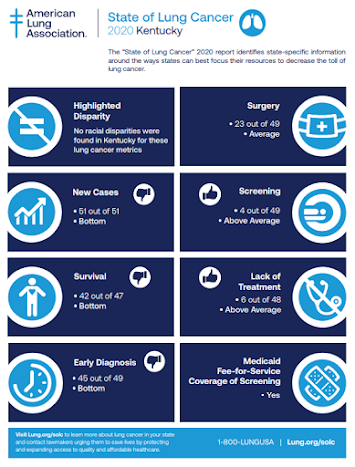New recommendations for CT scans to detect unknown lung cancer allow younger and lighter smokers to get checked

By Melissa Patrick
Kentucky Health News
More people now qualify for yearly low-dose scans to detect lung cancer, under new federal guidelines released Tuesday, March 9.
This is good news for Kentucky, since it leads the nation in lung cancer cases and ranks low in survival rates (42nd out of 46 states ranked) and early diagnosis (45th of 49) in early diagnosis, according to the American Lung Association.
Kentucky also has the second highest adult smoking rate in the nation, at 24%, with rates as high as 49% in some areas.
Cigarette smoking is the leading cause of lung cancer and deaths from it.
The new guidance recommends that anyone between 50 and 80 who has smoked at least 20 “pack-years” (a pack of cigarettes a day for a year or an equivalent amount, such as half a pack for two years) and either still smokes or has quit within the last 15 years is eligible for an annual low-dose computed tomography, commonly known as CT scans.
Since 2013, these scans have been recommended for people 55 to 80 who have smoked at least 30 pack years and currently smoke or have quit within the past 15 years.
The guidance, published in the Journal of the American Medical Association, comes from the U.S. Preventive Services Task Force, which points out that there is much room for expansion of these screenings. It notes a recent study of 10 states found only 14.4 percent of people eligible for screening under the 2013 guidelines had been screened in the prior 12 months. In Kentucky, that rate is 11.7%, according to the American Lung Association. The national rate is 5.7%.
The task force report walks through research supporting the benefits of such screening on younger people with lighter smoking histories, which found this was especially true among among Black and Hispanic people as well as women, who tend to accumulate fewer pack-years than men.
“About 15 million people are estimated to meet the new criteria, nearly double the prior number,” reports The Associated Press.
Following standard obligations, the task force notes that some potential harms are associated with low-dose CT scans, including “false-positive results leading to unnecessary tests and invasive procedures, over-diagnosis, radiation-induced cancer, incidental findings, and increases in distress or anxiety.”